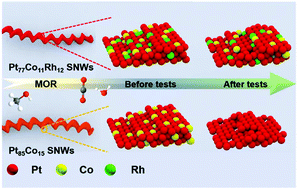Structure-intensified PtCoRh spiral nanowires as highly active and durable electrocatalysts for methanol oxidation†
Abstract
Platinum (Pt)-based nanocatalysts with a high density of surface atomic steps hold great prospects in electrocatalysis. However, the structural instability under harsh redox conditions is still a rigorous challenge. Here, we demonstrate that ternary PtCoRh alloyed spiral nanowires (SNWs), which have the advantages of one-dimensional nanowires, alloy synergy, surface atomic steps, and anti-corrosive Rh incorporation, can serve as active and robust MOR electrocatalysts in acidic media. The results showed that the Pt77Co11Rh12 SNWs delivered the highest mass activity (1.48 A mg−1) and specific activity (4.76 mA cm−2), as well as the best durability in the long-term MOR test, compared with the Pt85Co10Rh5 and Pt85Co15 SNWs and Pt black. Further inspections of the morphology, composition, and electronic structure revealed that the incorporated Rh atoms not only stabilized the highly rugged SNWs and the easily leaching Co atoms but also delicately tuned the electron transfer among the three metallic elements, leading to the enhancement of MOR activity, structural stability and anti-CO-poisoning ability. Our work provides a rational strategy for the development of highly efficient and durable alcohol oxidation electrocatalysts.



 Please wait while we load your content...
Please wait while we load your content...